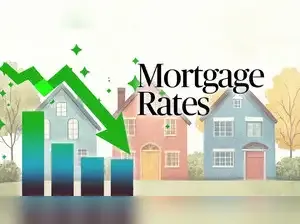Mortgage rates today are holding firm near their lowest levels of 2025, giving both homebuyers and refinancers a moment of relief. The average 30-year fixed mortgage rate sits at 6.16%, while the 15-year fixed is around 5.61%. Refinance rates hover slightly higher at 6.33%, keeping the housing market cautiously steady as buyers adapt to a higher-rate environment.
The mortgage market has been remarkably stable this week. Economic signals remain mixed—inflation is easing, but consumer spending and employment data continue to show strength. That combination has kept lenders hesitant to make aggressive cuts. For now, analysts say the chances of a sharp drop in mortgage rates before the end of 2025 are slim. Most expect a narrow range to continue through December.
Fixed-rate loans remain the most attractive choice for long-term borrowers. With a 30-year fixed mortgage, payments stay predictable, helping families plan with confidence. Even though interest costs are higher over time, the security of a locked-in rate is worth it for many buyers. Meanwhile, the 15-year fixed mortgage appeals to those aiming to pay off their homes faster and save on total interest, though the higher monthly payments can stretch budgets.
Adjustable-rate mortgages (ARMs), once popular for their lower introductory rates, have lost some appeal in recent months. The average 5/1 ARM rate is 6.54%, while the 7/1 ARM stands at 6.51%, both higher than fixed options. This inversion is unusual but reflects the market’s expectation that rates won’t fall significantly in the near term. For buyers planning to sell or refinance within five years, ARMs can still make sense, but the risks of future rate hikes remain high.
Refinance activity has picked up slightly as homeowners look to take advantage of small dips. The 15-year refinance rate averages 5.82%, offering potential long-term savings for those who can manage larger monthly payments. For VA loans, rates remain competitive—around 5.61% for a 30-year term and 5.35% for a 15-year. These government-backed loans continue to attract veterans and service members seeking lower-cost borrowing options.
Experts say the Federal Reserve’s next move could shape the year’s closing months. While there’s talk of another small rate cut, mortgage rates may not respond immediately. Lenders typically wait for clearer signs of economic slowdown before making adjustments. Even so, the current 6% range remains far below the peaks of 2023, when some 30-year loans topped 7.5%.
For many Americans, the housing market’s tone has shifted from panic to patience. Buyers are learning to navigate in a higher-rate world, focusing on affordability rather than chasing ultra-low deals from the past. Those who waited for 5% rates may not see them again soon, but locking in below 6.5% still represents a solid long-term move.
Mortgage rates today are not just numbers—they’re signals of a market balancing between inflation control and economic resilience. With 6.16% for a 30-year loan, 5.61% for a 15-year, and 6.33% for refinances, borrowers are finding stability after months of volatility. Experts agree that these levels are sustainable, and while dramatic drops aren’t expected, gradual improvement could come if inflation keeps cooling.
For homeowners thinking of refinancing, improving credit scores, reducing debt-to-income ratios, and comparing multiple lenders can make a real difference. Even a small cut in rates could save hundreds of dollars a month and thousands over the life of a loan. As 2025 winds down, one thing is clear: the mortgage market is steady, not stagnant. Rates near 6% may not feel like a bargain compared to the ultra-lows of 2020, but they’re a manageable middle ground. For buyers waiting for the “perfect moment,” today might be as close as it gets.
Experts say there’s little momentum for rates to move dramatically lower in the short term. Economic indicators are showing mixed signals—some data points suggest cooling inflation, while others show steady consumer spending and a firm job market. These factors keep lenders cautious about reducing rates further.
For now, the housing market appears to be adjusting to this “new normal.” Many buyers who had been waiting for deeper cuts are deciding to move forward, realizing that rates below 6% might not return soon. The good news? Even at current levels, today’s rates are far below the peaks seen earlier in the year.
These averages show a clear pattern — fixed-rate loans remain the most stable option for long-term homeowners. Adjustable-rate loans, while appealing for short-term buyers, carry uncertainty once the fixed period ends. That’s something borrowers should weigh carefully, especially in an unpredictable economy.
Refinance rates often run higher because they involve replacing an existing mortgage. Lenders assess risk differently for refinances, and fees can vary depending on loan size, equity, and timing. However, for homeowners who bought during the 2023–2024 high-rate period, even a small rate drop can mean meaningful savings over time.
If you’re considering refinancing, focus on improving your credit score, paying down high-interest debt, and comparing multiple lenders. Even a difference of 0.25% in rate can significantly impact your monthly payments. And if you’re switching to a shorter loan term, you might pay more each month but save thousands in total interest.
However, the trade-off is higher total interest costs over time. Because the loan stretches across more years, borrowers end up paying more even if the rate itself seems moderate.
On the other hand, the 15-year fixed mortgage appeals to those who want to build equity faster and pay less interest overall. Monthly payments are higher, but homeowners can become debt-free in half the time and save tens of thousands of dollars in the long run.
If you’re planning to stay in your home for a while and can comfortably afford the payments, the 15-year option is a strong financial move. But if flexibility is more important, the 30-year plan still offers security and breathing room in your budget.
However, today’s market paints a different picture — fixed-rate loans are currently cheaper than many ARMs, which isn’t typical. This means the short-term savings from an ARM may not be worth the future uncertainty. Once the introductory phase ends, the interest rate can rise sharply depending on market conditions, leading to higher payments.
Still, ARMs aren’t without merit. They suit borrowers with short-term housing plans or those confident in refinancing before rates climb. The key is understanding how much the rate can adjust and ensuring you’re financially ready if payments increase later.
Mortgage rates have slowly eased since the late-summer government shutdown, but the drop has been modest. Analysts expect rates to stay in a narrow range through the end of the year. Even if the Federal Reserve makes another small rate cut, mortgage lenders may keep rates steady until broader economic signals turn clearer.
The housing market remains sensitive to inflation and employment data. If inflation stays under control and job growth cools slightly, borrowing costs could dip again. But if prices rise faster or consumer spending stays hot, rates might edge higher in early 2026.
For now, the best strategy for homebuyers and refinancers is to stay alert, compare offers, and lock in a rate when it fits your financial plan. Rates near 6% are historically moderate — and given the past few years’ volatility, that’s a window worth considering.
The mortgage market has been remarkably stable this week. Economic signals remain mixed—inflation is easing, but consumer spending and employment data continue to show strength. That combination has kept lenders hesitant to make aggressive cuts. For now, analysts say the chances of a sharp drop in mortgage rates before the end of 2025 are slim. Most expect a narrow range to continue through December.
Fixed-rate loans remain the most attractive choice for long-term borrowers. With a 30-year fixed mortgage, payments stay predictable, helping families plan with confidence. Even though interest costs are higher over time, the security of a locked-in rate is worth it for many buyers. Meanwhile, the 15-year fixed mortgage appeals to those aiming to pay off their homes faster and save on total interest, though the higher monthly payments can stretch budgets.
Adjustable-rate mortgages (ARMs), once popular for their lower introductory rates, have lost some appeal in recent months. The average 5/1 ARM rate is 6.54%, while the 7/1 ARM stands at 6.51%, both higher than fixed options. This inversion is unusual but reflects the market’s expectation that rates won’t fall significantly in the near term. For buyers planning to sell or refinance within five years, ARMs can still make sense, but the risks of future rate hikes remain high.
Refinance activity has picked up slightly as homeowners look to take advantage of small dips. The 15-year refinance rate averages 5.82%, offering potential long-term savings for those who can manage larger monthly payments. For VA loans, rates remain competitive—around 5.61% for a 30-year term and 5.35% for a 15-year. These government-backed loans continue to attract veterans and service members seeking lower-cost borrowing options.
Experts say the Federal Reserve’s next move could shape the year’s closing months. While there’s talk of another small rate cut, mortgage rates may not respond immediately. Lenders typically wait for clearer signs of economic slowdown before making adjustments. Even so, the current 6% range remains far below the peaks of 2023, when some 30-year loans topped 7.5%.
For many Americans, the housing market’s tone has shifted from panic to patience. Buyers are learning to navigate in a higher-rate world, focusing on affordability rather than chasing ultra-low deals from the past. Those who waited for 5% rates may not see them again soon, but locking in below 6.5% still represents a solid long-term move.
Mortgage rates today are not just numbers—they’re signals of a market balancing between inflation control and economic resilience. With 6.16% for a 30-year loan, 5.61% for a 15-year, and 6.33% for refinances, borrowers are finding stability after months of volatility. Experts agree that these levels are sustainable, and while dramatic drops aren’t expected, gradual improvement could come if inflation keeps cooling.
For homeowners thinking of refinancing, improving credit scores, reducing debt-to-income ratios, and comparing multiple lenders can make a real difference. Even a small cut in rates could save hundreds of dollars a month and thousands over the life of a loan. As 2025 winds down, one thing is clear: the mortgage market is steady, not stagnant. Rates near 6% may not feel like a bargain compared to the ultra-lows of 2020, but they’re a manageable middle ground. For buyers waiting for the “perfect moment,” today might be as close as it gets.
Why are mortgage rates steady today?
Mortgage rates are holding steady this week, staying close to their lowest levels of 2025. The average 30-year fixed mortgage rate sits at 6.16%, while the 15-year fixed is around 5.61%. That means there hasn’t been much change from last week, giving buyers and refinancers a brief moment of stability in a year full of rate swings.Experts say there’s little momentum for rates to move dramatically lower in the short term. Economic indicators are showing mixed signals—some data points suggest cooling inflation, while others show steady consumer spending and a firm job market. These factors keep lenders cautious about reducing rates further.
For now, the housing market appears to be adjusting to this “new normal.” Many buyers who had been waiting for deeper cuts are deciding to move forward, realizing that rates below 6% might not return soon. The good news? Even at current levels, today’s rates are far below the peaks seen earlier in the year.
What are today’s mortgage rates across different loan types?
Here’s where average home loan rates stand today:- 30-year fixed: 6.16%
- 20-year fixed: 6.04%
- 15-year fixed: 5.61%
- 5/1 ARM: 6.54%
- 7/1 ARM: 6.51%
- 30-year VA: 5.61%
- 15-year VA: 5.35%
- 5/1 VA: 5.57%
These averages show a clear pattern — fixed-rate loans remain the most stable option for long-term homeowners. Adjustable-rate loans, while appealing for short-term buyers, carry uncertainty once the fixed period ends. That’s something borrowers should weigh carefully, especially in an unpredictable economy.
How are refinance rates behaving right now?
Refinancing activity is still moderate as homeowners look to reduce payments or shorten loan terms. The average 30-year refinance rate is currently 6.33%, slightly higher than the purchase rate. Shorter-term refinance options are also available: the 15-year refinance rate stands at 5.82%, while ARM refinance loans are hovering between 6.6% and 6.9%.Refinance rates often run higher because they involve replacing an existing mortgage. Lenders assess risk differently for refinances, and fees can vary depending on loan size, equity, and timing. However, for homeowners who bought during the 2023–2024 high-rate period, even a small rate drop can mean meaningful savings over time.
If you’re considering refinancing, focus on improving your credit score, paying down high-interest debt, and comparing multiple lenders. Even a difference of 0.25% in rate can significantly impact your monthly payments. And if you’re switching to a shorter loan term, you might pay more each month but save thousands in total interest.
Should you choose a 30-year or 15-year fixed mortgage?
A 30-year fixed mortgage remains the go-to option for most borrowers — and for good reason. It offers predictable monthly payments and the flexibility of lower installments spread over three decades. This makes it easier for first-time buyers or families balancing other expenses.However, the trade-off is higher total interest costs over time. Because the loan stretches across more years, borrowers end up paying more even if the rate itself seems moderate.
On the other hand, the 15-year fixed mortgage appeals to those who want to build equity faster and pay less interest overall. Monthly payments are higher, but homeowners can become debt-free in half the time and save tens of thousands of dollars in the long run.
If you’re planning to stay in your home for a while and can comfortably afford the payments, the 15-year option is a strong financial move. But if flexibility is more important, the 30-year plan still offers security and breathing room in your budget.
Are adjustable-rate mortgages still worth it?
Adjustable-rate mortgages (ARMs) attract buyers with lower initial rates. For example, a 5/1 ARM keeps the rate fixed for five years before adjusting annually. This can be useful for buyers who plan to move or refinance before the adjustment period ends.However, today’s market paints a different picture — fixed-rate loans are currently cheaper than many ARMs, which isn’t typical. This means the short-term savings from an ARM may not be worth the future uncertainty. Once the introductory phase ends, the interest rate can rise sharply depending on market conditions, leading to higher payments.
Still, ARMs aren’t without merit. They suit borrowers with short-term housing plans or those confident in refinancing before rates climb. The key is understanding how much the rate can adjust and ensuring you’re financially ready if payments increase later.
Mortgage rates have slowly eased since the late-summer government shutdown, but the drop has been modest. Analysts expect rates to stay in a narrow range through the end of the year. Even if the Federal Reserve makes another small rate cut, mortgage lenders may keep rates steady until broader economic signals turn clearer.
The housing market remains sensitive to inflation and employment data. If inflation stays under control and job growth cools slightly, borrowing costs could dip again. But if prices rise faster or consumer spending stays hot, rates might edge higher in early 2026.
For now, the best strategy for homebuyers and refinancers is to stay alert, compare offers, and lock in a rate when it fits your financial plan. Rates near 6% are historically moderate — and given the past few years’ volatility, that’s a window worth considering.








